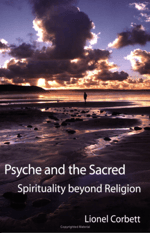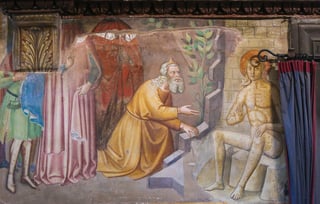Psyche and the Sacred: An Interview with Dr. Lionel Corbett. A guest post by Bonnie Bright, Ph.D.
 "You can't define the sacred," insists Pacifica professor and author, Dr. Lionel Corbett. "We can only talk about how we experience it. When C. G . Jung contemplated the sacred, he used the criteria of German theologian, Rudolf Otto, who described the experience of the sacred or the holy as “numinous”—that is, something that is mysterious, tremendous, or fascinating, having a powerful emotional quality beyond the ordinary or the everyday ego."
"You can't define the sacred," insists Pacifica professor and author, Dr. Lionel Corbett. "We can only talk about how we experience it. When C. G . Jung contemplated the sacred, he used the criteria of German theologian, Rudolf Otto, who described the experience of the sacred or the holy as “numinous”—that is, something that is mysterious, tremendous, or fascinating, having a powerful emotional quality beyond the ordinary or the everyday ego."
Corbett, a Jungian analyst who also trained in medicine and psychiatry, offers some stories from Biblical myth that exemplify such qualities of this experience. Rather than attributing such transformational events to the Judeo-Christian God, Corbett attributes them to what Jung calls the “objective psyche” or the “autonomous psyche.”
That means experiences of the sacred originate deeply in our own subjectivity, and not in some transcendent realm, according to Jung’s view. And these observations can take place for “ordinary, everyday people at any time.” Experiences of the sacred may carry the intense emotional quality of something extraordinary, dreadful, and amazing[1], perhaps offering nothing of our expectations about how the Divine should potentially manifest.
 Dreams are a very important source of such numinous experiences. Visionary experiences, which are like waking dreams, as well as synchronistic events, are also critically important. Corbett, in his decades long pursuit of understanding psyche and the sacred (See his 2007 book on the topic, Psyche and the Sacred: Spirituality beyond Religion[2]), is interested in how the sacred or the holy appears uniquely to individuals, and finds it often defies the way we might traditionally expect the sacred to manifest.
Dreams are a very important source of such numinous experiences. Visionary experiences, which are like waking dreams, as well as synchronistic events, are also critically important. Corbett, in his decades long pursuit of understanding psyche and the sacred (See his 2007 book on the topic, Psyche and the Sacred: Spirituality beyond Religion[2]), is interested in how the sacred or the holy appears uniquely to individuals, and finds it often defies the way we might traditionally expect the sacred to manifest.
The psyche is primed with an innate, organic wish to connect with something spiritual, something beyond the ordinary, Corbett believes. Our religious traditions have tried to channel that kind of instinctive wish to connect with the sacred through rituals and sacraments, but that is not the only valid way. In fact, revelation is continuing all the time if we know how to look.
“How we look” is by recognizing a certain quality of experience; by understanding how we, as individuals, encounter tremendous mystery, fascination, awe, or dread. Many people experience that in nature in the natural world (which is a better option than sitting inside and reading about it—a concept depth psychology pioneer, William James, called “second-hand religion,” Corbett points out).
People also experience the sacred within the powerful numinous imageries found in dreams. These portals to the numinous give us an innate image of the Divine in the psyche, which equals what Jung called the “Self” with a capital “S.” The Self is the maker of dreams, especially numinous dreams which arise from the deepest level of the psyche, or from the transpersonal or mythopoetic level of the psyche, which can tap into imagery of gods or goddesses from various traditions that are not necessarily your own. For example, for those raised in a Christian religion, the Divine may appear in dreams as Hindu deities, or God might show up as a woman. Such images must be understood metaphorically, not literally, Corbett insists. While traditions typically want to freeze or literalize the symbol (so that only one God image is the “correct” one as they see it), the Divine can, in fact, manifest itself in numerous ways.
Traditions serve as psychotherapeutic containers, Corbett explains, when I inquire as to why we have historically relied on traditional religions to fulfill us. If you are what Jung calls “contained in a tradition,” it can calm us, assuage our anxiety, and provided needed answers that help give meaning and purpose to life, he notes. These days, the traditional answers are no longer satisfying, however. Increasing numbers of people simply don't believe the old stories, which is why many Jungians think that a new God-image is emerging gradually, alongside our existing religious traditions. In this iteration, that God-image is going to be based on our own sense of connection to the objective psyche, to the bigger Self, which can take any form, Corbett believes.
When I look at some of numinous experiences in my own life, I recognize they have awakened me to something that I didn’t understand or have the capacity to envision before. Some of those experiences are what we might call grace. We can't intentionally create these kind of experiences, Corbett confirms. They are acts of grace in the sense that they're “given.” Some spiritual practices—like prayer, and meditation, and pilgrimage—may predispose us to a numinous experience, and sometimes they just erupt spontaneously for no obvious reason. “They are more likely to occur when we're suffering intensely because when we're suffering, it's as if the veil or the barrier between the ego, the everyday consciousness and the transpersonal of consciousness, is thinner,” Corbett acknowledges.
On the other hand, they may erupt at any time in surprising forms. Jungian thought tends to view numinous experiences as having a healing effect, because they can address a particular developmental difficulty from childhood even or resolve to a complex the person is dealing with. Typically, such numinous experiences are so emotionally powerful that that they can create a tremendous shift in those kinds of situations.
Corbett’s interest in such transpersonal, numinous experiences came from growing up with a strong personal sense of connection to something larger that he could never quite articulate. When he realized the existing religious traditions didn't address what he was feeling, he felt a sense of relief to encounter Jung’s works, because Jungian psychology allows one to articulate these kinds of “self-authenticating” experiences. “You don't need reference to doctrine or dogma or an established tradition to realize that you've encountered something which is very real and very important,” he maintains. With a psychological approach, it's important to be open to the God-images that arise, in whatever form they may take.
 When you pay attention to them, numinous experiences break through traditional stereotypes that we sometimes unconsciously hold as a result of our conditioning. And, so-called numinous experiences are not always positive, Corbett adds. We have to remember that Jung had a rather controversial notion of what he called the “dark side” of the Self. Of course, the loving and benevolent aspect of the God-image exists, but Jung believed that the Christian God-image was too light—too focused on love, goodness, and benevolence—while denying the darker aspects that cause suffering and evil which exists as well.
When you pay attention to them, numinous experiences break through traditional stereotypes that we sometimes unconsciously hold as a result of our conditioning. And, so-called numinous experiences are not always positive, Corbett adds. We have to remember that Jung had a rather controversial notion of what he called the “dark side” of the Self. Of course, the loving and benevolent aspect of the God-image exists, but Jung believed that the Christian God-image was too light—too focused on love, goodness, and benevolence—while denying the darker aspects that cause suffering and evil which exists as well.
Jung felt the traditional Christian view actually splits off the dark side of the Divine and projects it into the devil in order to maintain a purely good, loving God-image. In our individual experience, it’s hard to deny that the Self has a dark side. We recognize it. Some of the really dreadful, large-scale events in human history such as the Holocaust exemplify the dark side of the Self. But, while these experiences can manifest in nightmarish forms, they can also be numinous—mysterious, tremendous, fascinating—at the same time. This is a rather radical and often controversial idea, Corbett notes, which is antithetical to many of the religious notions of God.
In order to examine how a therapist might work with these experiences in therapy, Corbett offers the example of the Biblical figure of Job. In the Bible story, Job loses all his children in a storm. Then, bandits steal all his property. Finally, even his health is taken away from him. Job suddenly goes from being an affluent important man in his community to having almost nothing.
 Job can serve as an example of a character who might come for psychotherapy because he's suffering intensely, Corbett posits, (although Job’s suffering can be interpreted in a variety of ways). Traditional theologians might see it as a kind of test of Job’s faith, but from a depth psychological perspective, Corbett is profoundly interested in the way suffering transforms one’s personality.
Job can serve as an example of a character who might come for psychotherapy because he's suffering intensely, Corbett posits, (although Job’s suffering can be interpreted in a variety of ways). Traditional theologians might see it as a kind of test of Job’s faith, but from a depth psychological perspective, Corbett is profoundly interested in the way suffering transforms one’s personality.
Initially, Job was a man with a rather serious narcissistic character disorder: he was quite full of himself and his own self-importance, Corbett explains. Job was spiritually asleep. As a result of such intense suffering, however, he went through a radical transformation of his personality where he developed real empathy for those who were poor, or suffering, because he experienced those same conditions himself.
Equally importantly, Job experienced a radical transformation of his God-image. Initially, due to his upbringing and cultural conditioning, Job appeared to hold to a standard God-image, which suggests his suffering was punishment for his sins, requiring him to repent to change the situation.
In Jung’s prolific work, “Answer to Job,”[3] Jung insisted our closely-held God-image has to be transformed from a traditional Biblical view to a new God-image, which is highly individual and need not be based on any previous religious tradition. In Job’s case, his suffering was a numinous experience which provided an opening. Suffering is where we often encounter the numinous, Corbett maintains. We must look deeply to see it.
Corbett, who has recently begun offering “Psyche and the Sacred” retreat-style seminars, encourages people to explore their own spirituality through a depth psychological lens. He hosts weekend seminars which begin with Friday night discussions on a topic like suffering, evil, or the relationship of personality and spirituality. On Saturday and Sunday, participants gather in small groups where they share their own numinous experiences—their own unique and personal expressions of the sacred which can then be mirrored, reinforced, and validated by their peers in the group container.
Corbett’s own interest and dedication to the process is the result of a powerful desire to study the emergence of this new God-image, and the fascinating ways in which it's appearing to individuals today. Often those individuals who have had a powerful numinous experience haven't realized how important it is to them, or what the implications are to them, Corbett notes, so this initiative is in service to them as well as to the greater whole.
In closing, Corbett offers some final insights on the notion of a dark side of God, one which has powerful implications for our personal and collective transformation. First of all, for many of us, as well as for Jung, the God-image in the psyche is the nearest you can get to an experience of God. However, most of us experience the dark side of God in the form of intense suffering and evil. Jung believed that we couldn't—and shouldn't—attribute those experiences purely to humanity. In order to give proper weight to evil and suffering, we have to realize that there's an element of the Divine behind it.
Coming to terms with such a frightening notion can truly only occur if we are willing to deal with personal shadow material. We each possess a fragment of the archetypal shadow, Corbett reveals. Therefore, working on our personal shadow material can have a kind of redemptive effect on the collective shadow, which, in turn, influences the dark side of the Self (or God). It has to be done at the human level first.
I can’t think of a better way for each of us to reclaim our power and authenticity in today’s chaotic world—or to make meaning in life—than by committing to doing our individual work, and thereby contributing to the benefit and the well-being of the greater whole.
Listen to the full audio interview with Lionel Corbett here (approx. 35 mins):
Learn more about the Integrative Therapies and Healing Practices Specialization, for which Dr. Corbett teaches at Pacifica: www.pacifica.edu
Visit Dr. Corbett’s web site: psycheandthesacred.org or find “Psyche and The Sacred: A Contemplative Community” on LinkedIn
[1] Learn more about Otto’s concept of the numinous at http://www2.kenyon.edu/
[2] See a book review of Corbett’s “Psyche and the Sacred” by Sean Fitzpatrick for the C.G. Jung page, 2013: http://www.cgjungpage.org/
[3] Jung’s most extensive commentary on a Biblical text, “Answer to Job,” was first published in 1952 in German. It is included in Volume 11 of Jung’s Collected Works.
 Lionel Corbett received his Medical Degree from the University of Manchester, England, in 1966; served as a military physician; and became a Member of the Royal College of Psychiatrists in 1974. In the USA, he did fundamental research into the biochemistry of the brain; began one of the first programs in the psychology of aging; was a hospital medical director of in-patient psychiatry; trained as a Jungian analyst at the C. G. Jung Institute of Chicago 1978-1986; helped found a training program for Jungian analysts in Santa Fe, while carrying on a private practice and teaching psychiatry at the University of New Mexico. Dr. Corbett has studied various spiritual disciplines including Christian and Jewish mysticism, Buddhism, Advaita Vedanta, and Yoga and has had a personal meditation practice for 20 years. He currently teaches in the Integrative Therapy and Healing Practices Specialization and both Doctoral Clinical Psychology Programs at Pacifica Graduate Institute near Santa Barbara, California, and the author of 5 books, several training films, and about 40 professional articles.
Lionel Corbett received his Medical Degree from the University of Manchester, England, in 1966; served as a military physician; and became a Member of the Royal College of Psychiatrists in 1974. In the USA, he did fundamental research into the biochemistry of the brain; began one of the first programs in the psychology of aging; was a hospital medical director of in-patient psychiatry; trained as a Jungian analyst at the C. G. Jung Institute of Chicago 1978-1986; helped found a training program for Jungian analysts in Santa Fe, while carrying on a private practice and teaching psychiatry at the University of New Mexico. Dr. Corbett has studied various spiritual disciplines including Christian and Jewish mysticism, Buddhism, Advaita Vedanta, and Yoga and has had a personal meditation practice for 20 years. He currently teaches in the Integrative Therapy and Healing Practices Specialization and both Doctoral Clinical Psychology Programs at Pacifica Graduate Institute near Santa Barbara, California, and the author of 5 books, several training films, and about 40 professional articles.
Bonnie Bright, Ph.D., is a graduate of Pacifica’s Depth Psychology program, and the founder of Depth Psychology Alliance, an online community for everyone interested in depth psychologies. She also founded Depth Psychology List, a free-to-search database of Jungian and depth psychology-oriented practitioners, and she is the creator and executive editor of Depth Insights, a semi-annual scholarly journal. Bonnie regularly produces audio and video interviews on depth psychological topics. She has completed 2-year certifications in Archetypal Pattern Analysis via the Assisi Institute and in Dagara-inspired ritual and medicine with West African Elder Malidoma Somé, and she has trained extensively in Holotropic Breathwork™ and the Enneagram.



